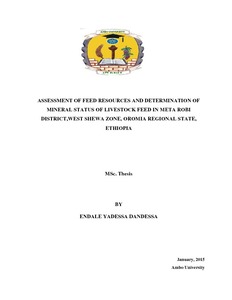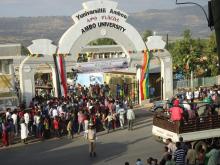Resource information
The study was carried out in Meta Robi district, West Shewa Zone, Oromia Regional State to identify the types and sources of feeds, constraints in feed production, transportation, utilization and supply, estimate annual feed produced, maintenance requirement, annual feed balance and determine the mineral status of natural pasture and soil samples. Secondary data sources and field observations, key informants discussions and semi-structured questionnaire interview were employed to generate data. The district was stratified into upper, mid and lower altitudes and a total of 90 respondents (upper=30, mid=30 and lower=30) were randomly selected and interviewed individually. Samples of feed and soil were collected from three altitudes during the dry and wet seasons and their mineral concentrations were determined. The results of the study indicated that the major feed resources were grazing of natural pasture (58.9%), wheat straw (42.4%), barley straw (30%) and hay (21.1%). During the dry season, 90% of the respondents feed their animal crop residues, hay (58.8%) and stubble grazing (56.1%). Natural pasture was the major feed source during the wet season. Most respondents (46.7%) had their own natural pasture lands, 86.7% produced crop residues from their crop land whereas only 25.6% were producing improved forages. The major constraints related to livestock feed were shortage of grazing land, absence of feed processors and retailers, shortage of technologies in feed production and lack of awareness of the respondents. The total maintenance DM of feed requirement of the animals per year in the district was 388,859.8 tons while the actual DM of feed production was 212,047.15 tons. The total DM of feed produced per year fulfilled the maintenance requirement of the animals only for 6.54 months of the year. Concentrations of most minerals in the soil were above the critical level of plant growth and most macro minerals in the feed were below the requirement of dairy animals while micro minerals were above the requirement of dairy animals except Mn. Alternative feed production technologies such as development of improved forages, efficient feed utilization technologies (eg. provision of chopper) and natural pasture land improvement measures should be taken. To compensate the mineral deficiency of natural pasture, improved forages with better yield and mineral contents should be provided for livestock. Provision of common salt and/or locally available natural soil as mineral source should be encouraged.



